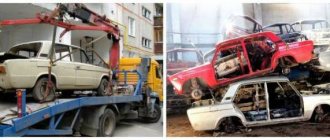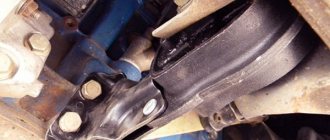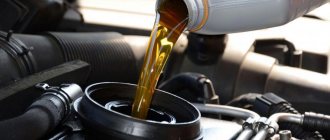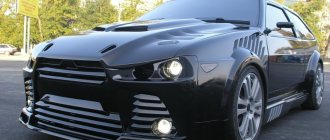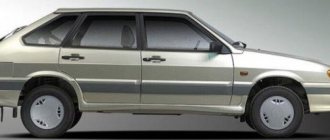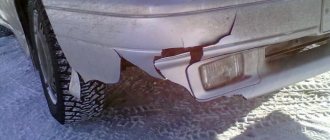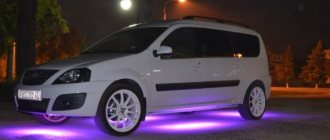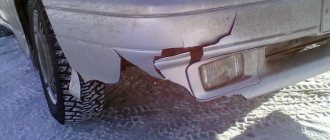History of creation
The VAZ 2112 hatchback model was produced since 1999, becoming the successor to the 2110 sedan and 2111 station wagon. The “Twelfth” became a close analogue of the famous tenth model, but had a slightly shortened body. As planned by the manufacturers, the 2112 was supposed to combine all the advantages of the “ten” and “eleven”, so the five-door hatchback was chosen as the body type.
VAZ-2112 Pre-production (1994)
The 12th model began to be mass produced in 2000; it lasted 8 years on the assembly line. Unlike the sedan and station wagon of the tenth series, the assembly of the “dvenashka” was not transferred to the Ukrainian ones.
Although the twelfth model was positioned as an improved “ten”, the improvements here are very conditional and not always obvious. Therefore, the difference between these two models is not too big. AvtoVAZ designers continued to look for new solutions, as a result of which other lines and modifications appeared, which also have both their pros and cons.
The body of the fourteenth model and its features
The fourteenth model can be said to belong to a new class of Russian cars, being as close as possible to foreign cars. At the same time, the VAZ 2114 still remains a people's car. However, if desired, the car owner can tune the car, easily turning it into a stylish sports car that has sweeping body lines and a modern body kit.
The body of this car brand is worth considering separately, since it has a very successful design solution. By analogy with other VAZ models, reliable bolted or welded connections are used to connect body parts. The entire body, including the most inaccessible places, is carefully treated with anticorrosive.
This fact does not exclude the need for additional processing, which is guaranteed to provide the body elements with additional resistance and durability.
The main difference between the VAZ 2114 body is its faceted shape. It is this that gives the model an attractive appearance. But there is also a drawback - corrosion processes more often affect hollow spaces in the frame. In this regard, we can highlight the front pillars, which suffer quite often in cars of the fourteenth model.
The front fenders of the car can be easily removed. The bumpers are made of plastic, but have additional reinforcement in the form of aluminum beams.
Exterior
Looking at the “twelve”, it immediately becomes clear that its prototype was the “ten”. Externally, these two cars are very similar, it is immediately clear that they belong to the same family: the same rounded, smooth lines and roundness of the body, the same heaviness, especially in the rear of the car. Of course, whether you like the design of the car is a matter of taste. Many note that the twelfth model is the most beautiful of the entire line.
Lada 2112 (1999–2008)
It is also noticeable that the designers tried to give the car some sportiness by adding a rather large spoiler to the trunk door, rounding the body as much as possible and replacing the thirteen-inch “tens” wheels with 14 inches. However, despite all the developers’ tricks, it’s quite difficult to call the 12th Lada sports. Changes also affected the roof of the car. Here it is more sloping, making the car look more interesting. The body length of the 2112 model is slightly shorter than that of the “ten”.
If we compare the car with the 11th model, then the rear door is noticeably larger, which can be opened both from the outside using the key and from inside the cabin by pressing the corresponding button. But the fifth door opens only if you pull it on the plastic spoiler, which does not have a positive effect on it.
Lada 2112 (1999–2008)
The trunk, like the hood, boasts gas struts. It is convenient to load, the volume is 400 liters. The shelf in the trunk rattles and knocks a lot when driving. You can get into the car through the trunk door if all other doors are blocked or jammed.
Interior
The interior of the car is simple and not very presentable. You won’t find any “bourgeois excesses” here. The only exception is electric windows and heated front seats, but this is not found in all modifications of the car.
The steering wheel is large and very antediluvian. The steering column is height adjustable only. Moreover, some models come without power steering and electric power steering, which is a significant disadvantage.
Torpedo Lada 2112 (2006-08)
To the right of the steering wheel is a console with a heater, radio, on-board computer (if equipped) and main keys. The heater, in theory, should be adjustable in order to separately heat the windows, top and bottom of the cabin, but in reality everything is heated at once. There are no airbags in the cabin.
The glove compartment is quite large and even has a backlight. The position of the exterior mirrors is adjusted by a special lever, but it is adjusted very mediocrely, so usually no one uses it.
A tall person is unlikely to be comfortable in the back row of seats, because his head will touch the ceiling. Long-legged people will also not be very comfortable, since there is quite a bit of space left to the front seats. The width of the cabin is cramped; only two passengers can be comfortably accommodated. Three people will fit, but they will be cramped.
Interior of Lada 2112 (1999–2008)
The rear windows are manual and constantly stick. As anyone who has ever owned a Lada, Zhiguli or any other AvtoVAZ product knows, the windows go down exactly to the level they want. Often it is completely impossible to lower the glass completely; it gets stuck in the middle and does not move anymore.
The rear row seats recline together or separately, which increases the size of the trunk, so you can put a fairly large load in the car.
Engine modifications
Under the hood of Lada 2112 (1999–2008)
In total, there are 6 engine modifications for the VAZ 2112:
- 21120 – the basic version of the 1.5 liter internal combustion engine. The disadvantage is the presence of free space inside the cylinder head and the block itself.
- 21124 – increased power (up to 89 hp) and increased engine capacity (up to 1.6 liters).
- 21126 – power increased to 98 hp. with an engine capacity of 1.6 liters.
- 21127 – the volume is still 1.6 liters, but the power is increased to 106 hp.
- 21128 – power is 105 horses, which is achieved by increasing the volume of the combustion chamber (1.8 liters). The problem with the valves bending has been resolved.
- 21129 – the engine has a volume of 1.8 liters, a phase shifter has been added.
Car weight VAZ-2112
The VAZ automobile concern regularly delighted car enthusiasts with new models, starting in the 60s of the last century. Each new car featured unique additions and improvements. Even the weight of the car increased from brand to brand due to additional modifications.
The total weight of the VAZ-2112 is 1060 kg. On average, the weight of the main components does not differ much between models. So:
- engine weight of model 2112 with a volume of 1.5 liters - 126 kg;
- gearbox weight – 27 kg;
- the radiator weighs 8 kg;
- the weight of the bare body of the VAZ-2112 is 290 kg.
It will be useful: Thermostat from grants for VAZ 2109 (carburetor, injector): installation features
The engine is considered an important unchanged part of the VAZ car, of course, over time it has undergone new modifications, but the basic basis has always been model 21083. While maintaining the basic parameters, the developers increased the power and engine service life in subsequent models.
The engine began to save fuel significantly, but there remained a lack of torque at low speeds. The rollers and belt drive are also unreliable, and if the timing belt breaks, there is a high probability of bending the valves.
Options
Lada 112 Coupe (2002–06)
The car was produced in several versions:
- 21120 – basic version with a 16-valve 1.5-liter engine with multipoint injection. Equipped with 14-inch wheels. Engine power – 93 hp.
- 2112i – version with fuel injection system.
- 21120 GLI (Gran Luxury Injector) – luxury version of the car.
- 21121 – modification with an engine capacity of 1.6 liters. Power – 81 hp
- 21122 – simplified, budget option. It was produced without electric windows, with 13-inch wheels and brakes from the VAZ 2108.
- 21123 Coupe - a three-door version, the so-called “coupe”, although in fact it is an ordinary three-door hatchback. It was assembled individually and in limited edition. The coupe's body is more rigid, as is the suspension. Handling is better than the standard version. The car was expensive, produced in 2002-2006.
- 21124 – injection version with a 1.6-liter engine. By increasing the depth of the groove in the piston crown, the creators managed to solve the problem of valve bending, which plagues the standard version.
- 21128 – modification with a 1.8-liter engine. Power – 105 hp.
- 2112-37 – racing version with a 1.5 liter engine, equipped with a roll cage.
- 2112-90 “Tarzan” – version with all-wheel drive. A Niva engine (1.7 and 1.8 liters) was installed.
The model was produced in several versions:
- 21120 with engine 21120 1.5 16 cl standard version, GLI luxury version.
- 21121 with engine 21114 1.6 8 cl.
- 21122 with engine 2111 1.5 8 cl budget version with 13 discs, non-ventilated brakes 2108, without power windows.
- 21124 with engine 21124 1.6 16 cl. Produced from 2004 to 2008. In this modification of the 2112 engine, the problem with valve bending was solved by increasing the depth of the grooves in the piston heads (up to 6.5 mm). In addition, the design of the cylinder block was changed to achieve a working volume of 1.6 liters, for which its height was increased by 2.3 mm, and the radius of the crankshaft was increased by 2.3 mm accordingly. There were also a number of other minor changes.
- 21128 with engine 1.8 16 cl 100 hp. luxury version of the car from Super-auto JSC.
- VAZ-21123 “Lada 112 Coupe” is a three-door modification of the VAZ-2112 car. It was produced in small series from 1999 to 2009. It went through three body modifications. Initially, it had a unique hood and bumper of the M series. Then it was produced with an M series bumper, its own grille and a standard hood. The car is a three-door hatchback, equipped with a 16-valve 1.6 liter engine and made in the “luxury” version. The term “coupe” appeared in its name solely as a marketing ploy. Although, compared to the usual 2112 and 21124, the car has a more rigid body, which makes it more responsive on the roads.
Specifications
Visibility
Visibility in the cabin is good, everything is perfectly visible from the driver's seat, the glass area is large. However, the rear view is partially blocked by the spoiler.
Body
The bodies of all Lada cars leave much to be desired. They are made of thin and very low quality metal that rusts instantly. The sills, arches and lower parts of doors are most susceptible to corrosion. If you find a VAZ 2112 in good condition, then both the arches and the sills will probably be overcooked.
Mileage
If you monitor the car and the condition of the engine, then the VAZ 2112 can “run” up to 200-250 thousand, which is not too much. On the other hand, the engine can be rebuilt or a new one installed, because Lada engines are obscenely cheap.
Lada 2112 (1999–2008)
The fuel consumption of the “twelfth” cannot but rejoice. So in urban conditions it consumes 7-9 liters per 100 km. On the highway - 5-6 liters.
Transmission
The 12th model was equipped with a 5-speed manual transmission. It differs from the gearbox on the VAZ 2110 only in name.
Disadvantages of a gearbox on a “two-wheeler”:
- unreliability;
- unclear switching;
- strong howl;
- frequent wear of the synchronizer, accompanied by crackling and noise when changing gears;
- oil leaks through seals, breather and gaskets;
- knockout of the gear or refusal to engage due to wear of the bushings;
- failure of bearings and gears after 100 thousand mileage.
Suspension
The front suspension of the VAZ 2112 is independent, the rear suspension is dependent. The problem with all LADA cars is CV joints and bearings that quickly fail. The struts also quickly begin to leak, the springs rust. The quality of spare parts generally leaves much to be desired, including new ones. Owners complain that some elements have to be replaced several times, because new parts arrive already defective or break in the first months of operation.
Ignition system
The VAZ 21124 16-valve engine is equipped with an ignition system consisting of NGK BCPR6ES or AU17DVRM spark plugs, a knock sensor and individual ignition coils. The latter are the third innovation in the design of the motor and improve its dynamic characteristics.
Engine control unit and its sensors.
This part is the “brain” of the power unit. It provides all the technical characteristics of the VAZ 21124 engine declared by the manufacturer. The block is designed to coordinate and synchronize the work of all subsystems. It receives information about the current state of the motor using sensors:
- Crankshaft position and speed.
- Mass air flow (MAF).
- Coolant temperature.
- Camshaft positions.
- Detonations.
- Throttle valve positions.
- Double lambda probe, which determines the amount of oxygen in the exhaust gases, installed before and after the converter.
- Rough road sensor.
The described engine is equipped with an ECU 21124 with a BOSCH M 7.9.7 controller, ensuring compliance with Euro 2 and 3 environmental standards.
Brake system
Front brakes are disc, rear brakes are drum. Although the brakes on the “two-wheeler” are quite mediocre and ineffective, owners most often do not complain about them, because repairs cost a small amount. The brake pedal is usually a little stiff, but the braking distance is acceptable.
Lada 2112 (1999–2008)
We will enter the remaining technical characteristics into the table.
| Parameter | Index |
| Body shape | hatchback (5 doors), coupe (3 doors) |
| Engine volume, l | 1.5, 1.6, 1.8 |
| Length, mm | 4170 |
| Width, mm | 1680 |
| Height, mm | 1420 |
| Wheelbase, mm | 2492 |
| Ground clearance, mm | 160 |
| type of drive | front |
| Gearbox type | 5-speed manual |
| Weight, kg | 1495 |
| Trunk volume, l | 400 |
| Fuel tank volume, l | 43 |
| Fuel type | petrol |
Technical characteristics of VAZ 2112
| Model | VAZ 2112 | ||
| Body type | hatchback | ||
| Number of seats | 5 | ||
| Number of doors | 5 | ||
| Trunk volume, dm3 | 400 | ||
| Car dimensions mm: | |||
| - length | 4170 | ||
| - width | 1680 | ||
| - height | 1435 | ||
| Own weight, kg | 1010 | ||
| 475 | |||
| Base, mm | 2492 | ||
| Front wheel track, mm | 1400 | ||
| Rear wheel track, mm | 1370 | ||
| Ground clearance mm | 165 | ||
| Ground clearance to the lowest point of the exhaust system, (mm) | 140 | ||
| Device Features: | |||
| Engine | 2112 | 2110 | 2111 |
| Tires | 13″ or 14″ | ||
| Drive wheels | front | ||
| Steering | rack and pinion | ||
| Front suspension | McPherson | ||
| Rear suspension | trailing arm | ||
| Number of gear stages | 5 | ||
| Gearbox ratios: | |||
| 1st gear | 3,636 | ||
| 2nd gear | 1,95 | ||
| III gear | 1,357 | ||
| IV gear | 0,941 | ||
| V gear | 0,784 | ||
| Reverse | 3,5 | ||
| Front brakes | disk | ||
| Rear brakes | drums | ||
| Parking brake drive | cable | ||
| Clutch drive | cable | ||
| Dynamic and operational characteristics: | |||
| Maximum speed with full load, km/h | 185 | ||
| Acceleration time to 100 km/h with full load, s | 12,5 | ||
| Minimum turning radius, m | 5,2 | ||
| Maximum lift angle | 34° | ||
| Braking distance from 80 km/h, m | 38 | ||
| Fuel consumption per 100 km, l | 5 | ||
| Fuel consumption at 120 km/h, liters per 100 km | 6,3 | ||
| Fuel consumption in the urban cycle, l | 8,8 | ||
| Fuel tank capacity, l | 43 | ||
| Weight of towed trailer with brakes, kg | 800 | ||
| Weight of towed trailer without brakes, kg | 400 | ||
| Cx - aerodynamic drag coefficient | 0,3 | ||
| Noise level in the cabin at 100 km/h, dB | no more than 72 | ||
The front-wheel drive VAZ 2112 is one of the most popular VAZ sports and youth models. The car was produced in a hatchback body (five-door solution), and later in a coupe body (three-door solution). The good aerodynamic performance of this car and the original, truly sporty design allowed domestic consumers to feel like truly happy owners of a powerful and stylish car. Only in 2010, the VAZ 2112 was ousted from the market by a new product - the Lada Priora in a hatchback body.
Engine characteristics
Car transmission
The classic VAZ manual gearbox in the VAZ 2112 also found its successful application.
Brake system and power steering
Like the previous model, the VAZ 2112 already has hydraulic power steering, which makes driving even more comfortable and, more importantly, safer. After all, now every movement of the driver is amplified with the help of hydraulics, and in a fraction of a second.
Tire size
Dimensions
Dynamics
VAZ 2112 cars showed truly sporting results, accelerating to the coveted 100 km/h in 12-13.5 minutes, depending on one or another modification and engine power. At the same time, the maximum speed, unlike its predecessor, was limited to 170 kilometers per hour.
Fuel consumption
The VAZ-2112 model during its production period underwent many changes and various modifications, not all of which were popular with consumers:
- 21120 – engine with the same number as the modification, with 16 valves according to the standard GLI luxury version of one and a half liters;
- 21121 – engine 21114, 1.6 liters with 8 valves;
- 21122 – engine 2111, volume one and a half liters, with 8 valves, budget version with 13 discs, without power windows, with non-ventilated brakes 2108;
- 21124 - with an engine of the same marking as the modification, but with 16 1.6 liter valves. It was produced until 2008. Despite the problem with valve bending, which was solved almost after the car was taken out of production. To achieve engine displacement from 1.5 to 1.6, the cylinder block changed significantly, becoming 2.3 mm higher, which accordingly affected the dimensions of the crankshaft parts;
- 21128 – 16 valves, engine with the maximum volume for this model (1.8 l). Luxury version from Super-auto JSC.
One of the versions of the VAZ-21123 was produced right up to 2009, but it was already a three-door and was produced in small series. The three-door hatchback had a 16-valve 1.6-liter engine in a luxury version. It was for this model that the term “coupe” was first used as a marketing ploy. But, besides this, this development had a body that was much stiffer and allowed the car to become more responsive on the road.
If you often transport medium-sized cargo, which includes products from your dacha, the VAZ-2112 car model will be the best option for you. The benefits of a large luggage compartment are obvious, and the ergonomic interior with folding rear seats doubles the cargo capacity.
Small class cars
VAZ-2110
(export name
LADA
110) with a four-door five-seater sedan body (class C according to the international classification) are equipped with injection engines with a displacement of 1.6 liters: eight-valve mod.
VAZ-21114 with a power of 80.2 hp. and sixteen-arm mod. VAZ-21124 with a power of 89.1 hp. The engines are located across the engine compartment, equipped with a three-component exhaust gas catalyst with feedback and meet Euro-2 and Euro-3 standards. Previously, cars were equipped with engines with a displacement of 1.5 liters: first carburetor and then injection. Rice. 1.1. Overall dimensions
VAZ-2110
car The body is load-bearing, all-metal, of welded construction with hinged doors, front fenders, hood and trunk lid.
A hatch that opens from the trunk leading into the cabin allows you to transport long items. Part of the production of modification 21103 with a 16-valve VAZ-2112 engine is equipped with air conditioning, and since the end of 2002, on request, with power steering from ZF. This modification differs from the basic one by a hood with an integrated radiator lining of a more modern shape and a front bumper, as well as original headlights. The rear lights, moldings and interior details have also been changed. In 1998, production of the VAZ
-2111 car (export name
LADA
111) with a station wagon body began.
According to the layout, engine, transmission, chassis, body equipment, this car is identical to the VAZ-2110 car. It differs only in a modified rear end with a large tailgate. The trunk of this car is the most spacious in the family: 490 liters with the rear row of seats raised and 1420 liters with them folded. Production of the VAZ
-2112 car (export name
LADA
112) with a hatchback body began in 2000. The layout of this car is the same as that of the VAZ-2111, but the body has a large rear angle. This car model uses only injection engines: both 8-valve and 16-valve. The rear seat folds in a 2:3 ratio, which allows you to increase luggage capacity from 415 to 1270 liters. Rice. 1.2. Overall dimensions of the VAZ-2111 car The salon, like other models of the family, is equipped in “standard”, “norm” and “luxury” trim levels. The latest equipment includes fog lights, headlight cleaner and washer, 14-inch alloy wheels, three-way catalytic converter (Euro-2), internal sound-insulating hood trim, door safety bars, immobilizer, on-board monitoring system, seat upholstery made of velvet and soft door upholstery, central electric door locking, electric windows. By additional order, an on-board computer, electric front seat heaters, electric outside rear-view mirrors, anti-lock brakes, an airbag and a sunroof are installed. Rice. 1.3. Overall dimensions of the VAZ-2112 car
| Like | Tweet |
Your reviews, comments, questions and answers to the site
Everyone is welcome to participate in the discussion about the causes of the malfunction and other problems. If you know what to answer, write and thereby help other VAZ 2110 owners in searching for the truth.
| Eliza 2016-06-01 00:54:14 It"sa relief to find soneome who can explain things so well |
| Ruslan 2014-05-06 19:37:23 In 2112, between the center of the rear wheel and the end of the rear bumper is not 949 mm, but less. [Reply] [Cancel reply] |
On a VAZ 2112, the geometric dimensions of the body will definitely be needed by the owner who intends to independently correct or restore the parts. The situation on the roads has been extremely depressing lately. Due to the large number of vehicles, motorists are more likely to be involved in accidents, major and minor. The owners of “two-wheelers”, of whom there are a lot in Russia, are no exception in this regard. Find out from the article how the geometric dimensions of the VAZ 2112 body affect the ease of driving and which parts on this model are most quickly subject to deformation.
Controllability
It would seem that the reduced base (when compared with the “ten”) should have made the car more obedient, but for some reason everything is different with the “two”. Handling here is very mediocre. When turning, you often have to fight with the steering wheel, which constantly strives to return to its original position. There are cars without power steering, the driving of which gives little pleasure, and the steering wheel seems to be filled with lead and generally refuses to rotate adequately.
Lada 2112 (1999–2008)
When cornering, the body often begins to sway and roll to the side, causing the wheels to lose traction on the asphalt. This happens especially often on rough roads. It is better not to accelerate too much in the VAZ 2112, because at high speeds you can easily lose control.
Competitors
Fiat Albea
Fiat Albea (2002–05)
The Fiat Albea is a reliable four-door sedan, very cheap and unpretentious. On the secondary market you can find versions with an engine capacity of 1.4 and 1.6 liters. Albea's body is galvanized, so there are cars with whole metal. This option is perfect for city driving. If you are considering buying a VAZ 2112 specifically for city driving, then the Fiat Albea will be an excellent replacement. Comfort, like any foreign car, will be higher than that of the Lada, there is air conditioning. The build quality is also higher, the sound insulation is satisfactory.
LADA 2114
Lada Samara 2114 (2001–13)
VAZ 2114 is the older sister of the “twelfth”, which is also not intended for high-speed driving and has very mediocre handling. This is a great option for fishing trips. The car, due to its lighter weight, drives perfectly through the fields, it can be rocked and pulled out of any large puddle or hole.
The “fourteenth” does not have a hydraulic booster, but the steering wheel nevertheless rotates well. The 14 is lighter, making it easier to ride off-road, but the lighter weight means less stability on the trail. In strong winds and on sharp turns, the car easily lifts off the ground.
This car, like the 12th model, is suitable for beginners and young people who do not have money for a more expensive and high-quality car.
ZAZ Chance
ZAZ Chance Hatchback (2009–14)
This is another representative of the ultra-budget segment. Like all other domestically produced machines, it is characterized by low quality and low cost. Its interior is a little more comfortable and visually pleasing than that of the VAZ.
Modifications
| Name | Year of issue | |
| LADA 110 (2110) 1.5 | 01.1995 – 12.2005 | Characteristics |
| LADA 110 (2110) 1.5 | 01.1995 – 12.2005 | Characteristics |
| LADA 110 (2110) 1.5 16V | 01.1995 – 12.2005 | Characteristics |
| LADA 110 (2110) 2.0 i | 08.1996 – 07.2000 | Characteristics |
| LADA 110 (2110) Wankel | 06.1997 – 09.2004 | Characteristics |
| LADA 110 (2110) 1.5 | 10.2000 – 12.2005 | Characteristics |
| LADA 110 (2110) 1.5 16V | 10.2000 – 12.2010 | Characteristics |
| LADA 110 (2110) 1.6 | 01.2000 – 12.2012 | Characteristics |
| LADA 110 (2110) 1.6 | 01.2000 – 04.2007 | Characteristics |
Advantages and disadvantages
The main advantage of the Lada, as mentioned earlier, is its low cost. Spare parts can be found everywhere. Even in small towns there are car services with domestic spare parts. Repairs are very cheap.
The remaining pros and cons of the VAZ 2112 are listed in the table for convenience.
| pros | Minuses |
| Cheapness and availability of spare parts | Rapidly rotting body metal |
| Large trunk, expanding due to the rear seats | Low ceilings in the cabin, which is inconvenient for tall people, the cabin is cramped |
| Maneuverability in urban environments | Poor handling |
| Low gasoline consumption, economical | Low quality plastic |
| Powerful stove | Lack of vibration and noise insulation in the cabin |
| Good forward visibility | Low quality of elements and spare parts, frequent breakdowns |
| Nice glass headlights | No airbags |
| Low road tax | No air conditioning |
| Passability on broken and rural roads | Rear view suffers due to protruding spoiler |
| Nice appearance | No power steering |
| Possibility of tuning and restyling | Valve bending when timing belt breaks |
Reviews from VAZ 2112 owners
I bought the car in 2009 with a mileage of 86 thousand kilometers. I immediately changed the brake pads, fluids, and filled the engine with oil. Afterwards I had to change the front struts, bearings, ball joints and steering ends. I haven’t repaired the engine, it doesn’t eat my oil, I’ve added about half a liter over the course of a year. I also changed the front brake discs and pads. Among the advantages, I can mention the engine, a pleasant interior, a spacious trunk, good acoustics and a radio. The car drives smoothly, the gears shift clearly, the braking system is adequate, the steering is sensitive (I have power steering).
Andrey, Samara
I drove a car for a year and can refute all the stereotypes about the domestic automobile industry. Gasoline consumption on the highway is 5 liters, in the city - 7-8! Where else will you find this? Over 20 thousand mileage, only the ignition and consumables were changed: timing belt, spark plugs, gaskets, pipes, etc. Sometimes something leaks, but this is a LADA. We are thinking of selling because we want a newer and more comfortable car, but it’s a shame. Cons: there is no sound insulation at all, but my husband and I taped the trunk and all the doors, it became much quieter. My husband is too lazy to glue the panel. If you're wondering whether it's worth taking, then go for it. As a first car, it’s simply super, especially for young people.
Ekaterina, St. Petersburg
VAZ 2112 is an inexpensive and marketable car with good cross-country ability. I took it to go to work, to the dacha, fishing and to the forest to pick mushrooms. It’s absolutely not a pity to break it on our roads. Naturally, there is no suspension, the CV joints are all crunchy, it all needs to be sorted out. The turning radius is large, visibility is also not very good, especially from the rear. Factory wheels bend a lot, although they straighten out easily. The biggest disease is valve bending if the timing belt breaks. Another disadvantage: everything in the cabin creaks and rattles, the rear shelf from the subwoofer shakes and makes terrible sounds. But for this amount of money the car is excellent. No show-offs or bells and whistles, but cheap to maintain and quite unpretentious.
Evgeniy, t. Tver
As for me, if you choose from the Lada model range, then its appearance is the most beautiful. The interior is comfortable, I have a European panel, seats with lateral support. The dynamics are normal. I had power steering included, which is generally nice for a VAZ. The ride is good, the suspension is just right for driving on our rough roads. Naturally, after a foreign car you feel that the handling is not very good, but overall it’s normal. The reviews write that the struts on the VAZ 2112 quickly die, but everything is fine for me, I drove for 45 thousand and didn’t change anything at all, then I sold it. The build quality is, of course, terrible. And something is constantly leaking, either from the box or antifreeze. It’s better to buy a cheap two-wheeler with cheap spare parts than a junked foreign car.
Sergey, Pskov
I can say that for 100 thousand I definitely wouldn’t have bought a better car. “Classics” don’t appeal to me at all. The cross-country ability of the VAZ 2112 was surprising. I drove it to the dacha on broken roads and to pick mushrooms. She coped better than many foreign passenger cars. Maintainability is also excellent. I easily changed everything myself, spending pennies. Spare parts are much cheaper than for foreign cars. The stove heats well, the cabin is warm in winter, but it warms the legs slowly. The rear seats recline comfortably. I carried boxes of tomatoes, potatoes, pumpkins, and a bunch of bags. Of course, there are also disadvantages. Sound insulation is terrible. I glued the doors, it got better, but the noise still remained. Everything shakes and rattles, the plastic is disgusting. The torpedo makes a lot of noise, especially on dirt roads. Handling on the highway is poor. It’s fine in the city, but on the highway it’s really scary to accelerate above a hundred, it’s very unsafe. The low beam headlights are weak.
Anastasia, Minsk
How much does the VAZ weigh?
Perhaps one of the most popular cars in the post-Soviet space was, is and remains the VAZ. This car has captivated many generations. However, how did it all begin? When was the first VAZ car produced and how much did it weigh? You will learn the answers to these and other questions from this article.
The first VAZ car was produced by the Volzhsky Automobile Plant on April 19, 1970. The make of this car was VAZ-2101 Zhiguli. Its production was carried out according to the analogue of the Fiat concern. Moreover, VAZ owes its appearance to this particular brand of Fiat 124, produced in 1966. Here, in fact, is it:
As a result of some design improvements, the first domestic car, the VAZ 2101 of 1970, was produced:
The weight of this car was 955 kg. Moreover, of this mass the engine weighed 114 kg.
It has not lost its popularity to this day. In 2000, it was recognized as the best car among eighty thousand car enthusiasts surveyed in the CIS countries and Russia. It was named the best car of the century, VAZ 2101. At the time of its production, it was considered the most comfortable, reliable and modern domestic car. Its presence was a sign of wealth and prosperity!
But the Volzhsky Automobile Plant did not stop there. He created entire collections of this car. Each of them differed in its configuration, as well as its total weight. Therefore, now we will compare some VAZ models by their weight.
- VAZ 2102 has a weight of 1010 kg .
- VAZ 2103 has a weight of 965 kg .
- VAZ 2104 has a weight of 1020 kg .
- VAZ 2105 has a weight of 1060 kg .
- VAZ 2106 has a weight of 1045 kg .
- VAZ 2107 weighs 1049 kg .
- VAZ 2108 weighs 945 kg .
- VAZ 2109 weighs 915 kg .
- VAZ 2110 has a weight of 1020 kg .
- VAZ 2111 has a weight of 1055 kg .
- VAZ 2112 has a weight of 1060 kg .
- VAZ 2113 weighs 975 kg .
- VAZ 2114 weighs 985 kg .
- VAZ 2115 has a weight of 1000 kg .
- VAZ 2116 weighs 1276 kg .
- VAZ 2117 has a weight of 1110 kg .
- VAZ 2118 has a weight of 1110 kg .
- VAZ 2119 has a weight of 1110 kg .
- VAZ 2120 has a weight of 1110 kg .
- VAZ 2121 has a weight of 1550 kg .
- VAZ 2122 has a weight of 1122 kg .
- VAZ 2123 has a weight of 1300 kg .
But this is the total weight of a VAZ car. As for some parts of the car, the weight of, for example, a VAZ 2106 can be decomposed as follows:
- The weight of the engine with equipment is 140 kilograms .
- The weight of the gearbox is 26 kilograms .
- The weight of the square shaft is 10 kilograms .
- The weight of the rear axle is 52 kilograms .
- Radiator weight – 7 kilograms .
- Body weight – 280 kilograms .
It will be useful: Fuel consumption per 100 km on a Lada Granta 8 and 16 valves on the highway and in the city: what factors influence the performance depending on the type of engine and road conditions
On average, the weight of all components of a VAZ car has approximately the same mass. Throughout the entire period of existence of this car, quite interesting facts have been recorded that simply cannot be ignored. It’s hard to imagine that a car weighing an average of 1 ton is very popular.
So, the VAZ 2121 Niva car is not only the most popular throughout the USSR, but also the most exported. Just imagine, this model was produced in 1.8 million cars. And of this amount, 500,000 were sold to more than 100 countries. As we remember, the weight of the VAZ 2121 is 1550 kilograms . This means that over the entire period, 775,000,000 kilograms of this car were sold! Also, this particular model of all Soviet cars was driven in Japan. As for the design of the VAZ 2108, it was developed by the currently well-known company Porshe. Its engine weighs 127.3 kilograms . This became necessary due to the fact that the demand for this brand of car was greatly reduced. For this reason, they decided to modernize it.
Moreover, the VAZ car became more popular because the Lada car was the first car of the famous Formula 1 racer - Kimi Raikkonen. His father loved this car extremely much for its reliability.
So, we learned that each VAZ car model has its own separate weight. But throughout the history of its existence and production, it has not undergone major changes.
